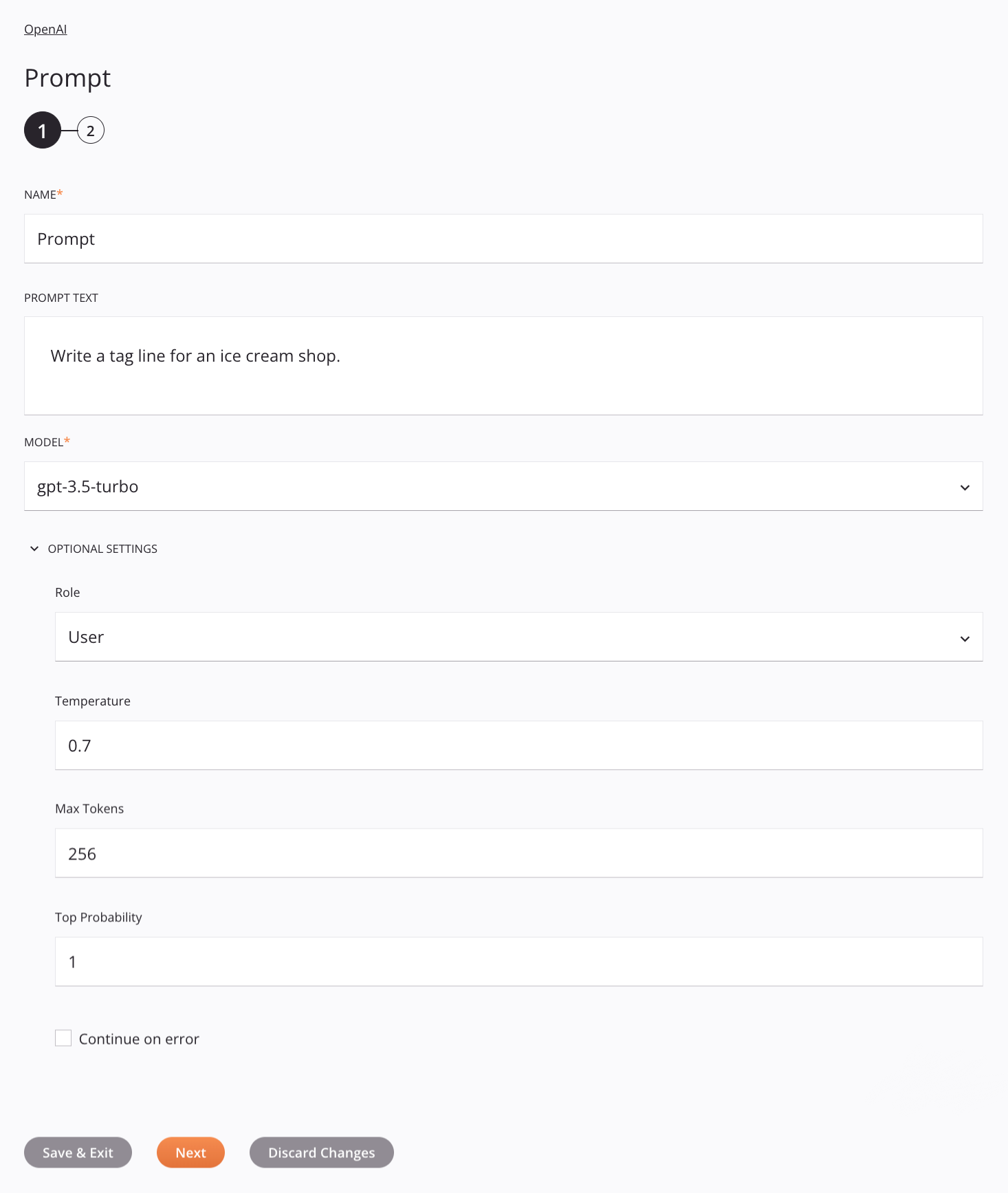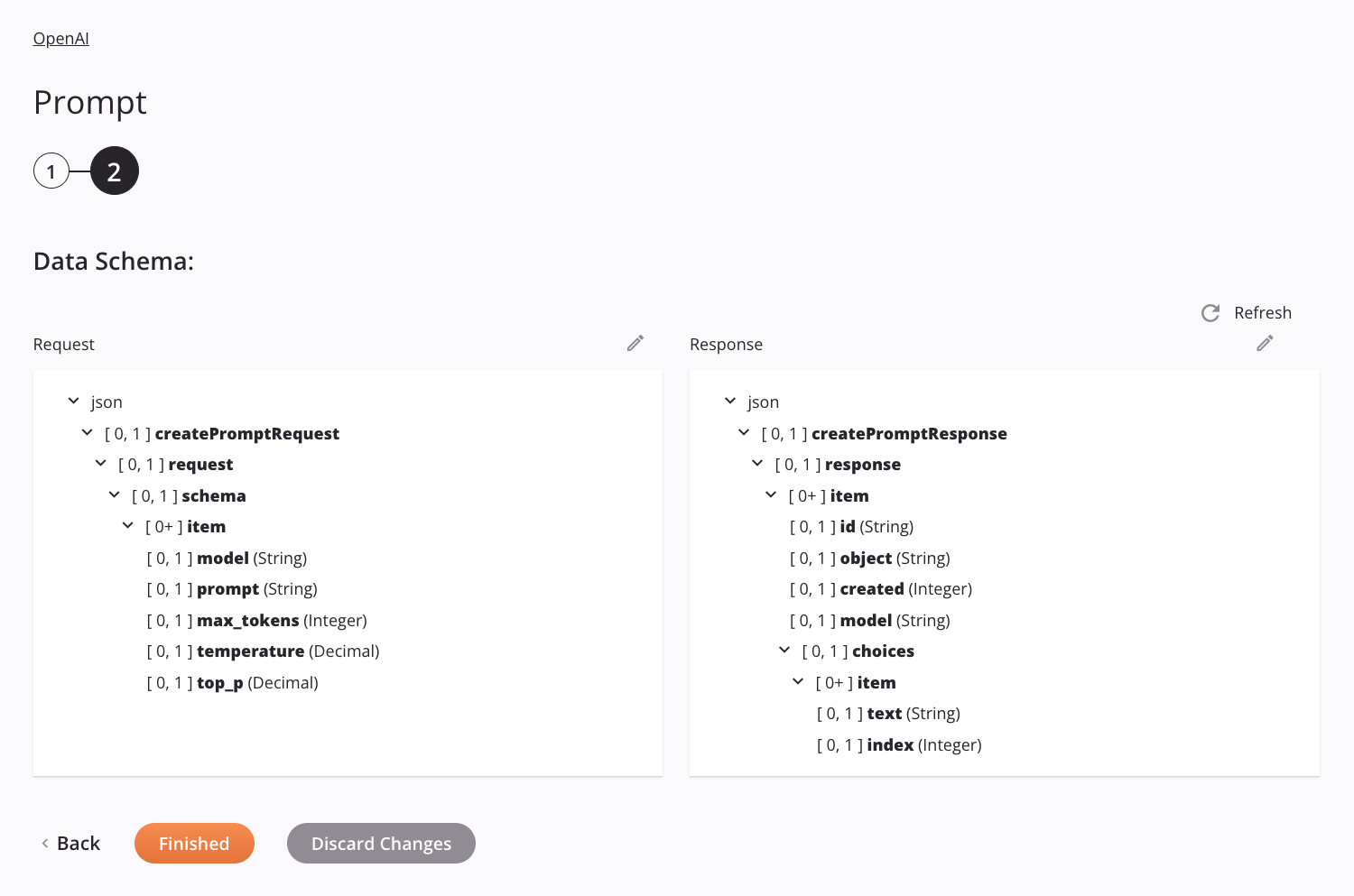OpenAI Prompt activity
Introduction
An OpenAI Prompt activity, using its OpenAI connection, creates a text completion for the provided prompt in OpenAI and is intended to be used as a target to consume data in an operation.
This activity can be configured to use one of these OpenAI models:
-
One of these GPT-3.5 Turbo models:
gpt-3.5-turbogpt-3.5-turbo-instruct
-
GPT-4o (
gpt-4o)
Create an OpenAI Prompt activity
An instance of an OpenAI Prompt activity is created from an OpenAI connection using its Prompt activity type.
To create an instance of an activity, drag the activity type to the design canvas or copy the activity type and paste it on the design canvas. For details, see Create an activity instance in Component reuse.
An existing OpenAI Prompt activity can be edited from these locations:
- The design canvas (see Component actions menu in Design canvas).
- The project pane's Components tab (see Component actions menu in Project pane Components tab).
Configure an OpenAI Prompt activity
Follow these steps to configure an OpenAI Prompt activity:
-
Step 1: Enter a name and specify settings
Provide a name for the activity and specify the prompt text and optional settings. -
Step 2: Review the data schemas
Any request or response schemas are displayed.
Step 1: Enter a name and specify settings
In this step, provide a name for the activity and specify the prompt text and optional settings. Each user interface element of this step is described below.

-
Name: Enter a name to identify the activity. The name must be unique for each OpenAI Prompt activity and must not contain forward slashes
/or colons:. -
Prompt Text: Enter the prompt to be used for the completions.
-
Model: Use the menu to select the model to use. Select one of the GPT base, GPT-3.5 Turbo , or GPT-4o models.
-
Optional Settings: Click to expand additional optional settings:
-
Role: Select the prompt's role, either Assistant, System, or User:
-
Assistant: An assistant (the model) responds to the user's prompt. An assistant prompt stores previous assistant responses or can be written by you to give examples of desired behavior. This is an example of an assistant prompt:
You have an extensive knowledge of 16th century French. -
System: A system prompt sets the behavior of the assistant. You can modify the personality of the assistant or provide specific instructions about how it should behave. This is an example of a system prompt:
When I ask for help to write something, you will reply with a document that contains at least one joke or playful comment in every paragraph. -
User: A user prompt is a request to the assistant. This is an example of a user prompt:
Write a Markdown list of cat breeds and a personality trait for each breed.
-
-
Temperature: Enter the sampling temperature. The value must be a decimal between
0and2. It is not recommended to use this setting with Top Probability. -
Max Tokens: Enter the maximum number of tokens to be used.
-
Top Probability: Enter the top probability. It is not recommended to use this setting with Temperature.
-
-
Continue on Error: Select to continue the activity execution if an error is encountered for a dataset in a batch request. If any errors are encountered, they are written to the operation log.
-
Save & Exit: If enabled, click to save the configuration for this step and close the activity configuration.
-
Next: Click to temporarily store the configuration for this step and continue to the next step. The configuration will not be saved until you click the Finished button on the last step.
-
Discard Changes: After making changes, click to close the configuration without saving changes made to any step. A message asks you to confirm that you want to discard changes.
Step 2: Review the data schemas
Any request or response schemas are displayed. Each user interface element of this step is described below.

-
Data Schemas: These data schemas are inherited by adjacent transformations and are displayed again during transformation mapping.
Note
Data supplied in a transformation takes precedence over the activity configuration.
The OpenAI connector uses the OpenAI API. Refer to the API documentation for information on the schema nodes and fields.
-
Refresh: Click the refresh icon
 or the word Refresh to regenerate schemas from the OpenAI endpoint. This action also regenerates a schema in other locations throughout the project where the same schema is referenced, such as in an adjacent transformation.
or the word Refresh to regenerate schemas from the OpenAI endpoint. This action also regenerates a schema in other locations throughout the project where the same schema is referenced, such as in an adjacent transformation. -
Back: Click to temporarily store the configuration for this step and return to the previous step.
-
Finished: Click to save the configuration for all steps and close the activity configuration.
-
Discard Changes: After making changes, click to close the configuration without saving changes made to any step. A message asks you to confirm that you want to discard changes.
Next steps
After configuring an OpenAI Prompt activity, complete the configuration of the operation by adding and configuring other activities, transformations, or scripts as operation steps. You can also configure the operation settings, which include the ability to chain operations together that are in the same or different workflows.
Menu actions for an activity are accessible from the project pane and the design canvas. For details, see Activity actions menu in Connector basics.
OpenAI Prompt activities can be used as a target with these operation patterns:
- Transformation pattern
- Two-transformation pattern (as the first or second target)
To use the activity with scripting functions, write the data to a temporary location and then use that temporary location in the scripting function.
When ready, deploy and run the operation and validate behavior by checking the operation logs.